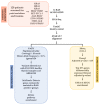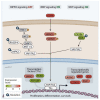Evidence of Cooperation between Hippo Pathway and RAS Mutation in Thyroid Carcinomas
- PMID: 34065786
- PMCID: PMC8151534
- DOI: 10.3390/cancers13102306
Evidence of Cooperation between Hippo Pathway and RAS Mutation in Thyroid Carcinomas
Abstract
Thyroid cancer incidences have been steadily increasing worldwide and are projected to become the fourth leading cancer diagnosis by 2030. Improved diagnosis and prognosis predictions for this type of cancer depend on understanding its genetic bases and disease biology. RAS mutations have been found in a wide range of thyroid tumors, from benign to aggressive thyroid carcinomas. Based on that and in vivo studies, it has been suggested that RAS cooperates with other driver mutations to induce tumorigenesis. This study aims to identify genetic alterations or pathways that cooperate with the RAS mutation in the pathogenesis of thyroid cancer. From a cohort of 120 thyroid carcinomas, 11 RAS-mutated samples were identified. The samples were subjected to RNA-Sequencing analyses. The mutation analysis in our eleven RAS-positive cases uncovered that four genes that belong to the Hippo pathway were mutated. The gene expression analysis revealed that this pathway was dysregulated in the RAS-positive samples. We additionally explored the mutational status and expression profiling of 60 RAS-positive papillary thyroid carcinomas (PTC) from The Cancer Genome Atlas (TCGA) cohort. Altogether, the mutational landscape and pathway enrichment analysis (gene set enrichment analysis (GSEA) and Kyoto Encyclopedia of Genes and Genome (KEGG)) detected the Hippo pathway as dysregulated in RAS-positive thyroid carcinomas. Finally, we suggest a crosstalk between the Hippo and other signaling pathways, such as Wnt and BMP.
Keywords: Hippo pathway; RAS mutation; RNA-Seq; TCGA; thyroid cancer.
Conflict of interest statement
The authors declare that the research was conducted in in the absence of any commercial or financial relationships that could be interpreted as a potential conflict of interest.
Figures








Similar articles
-
The diagnostic application of RNA sequencing in patients with thyroid cancer: an analysis of 851 variants and 133 fusions in 524 genes.BMC Bioinformatics. 2016 Jan 11;17 Suppl 1(Suppl 1):6. doi: 10.1186/s12859-015-0849-9. BMC Bioinformatics. 2016. PMID: 26818556 Free PMC article.
-
Molecular characterization of tumors meeting diagnostic criteria for the non-invasive follicular thyroid neoplasm with papillary-like nuclear features (NIFTP).Virchows Arch. 2019 Mar;474(3):341-351. doi: 10.1007/s00428-018-02512-6. Epub 2019 Jan 15. Virchows Arch. 2019. PMID: 30645670
-
ras mutations are associated with aggressive tumor phenotypes and poor prognosis in thyroid cancer.J Clin Oncol. 2003 Sep 1;21(17):3226-35. doi: 10.1200/JCO.2003.10.130. J Clin Oncol. 2003. PMID: 12947056
-
Evidence that one subset of anaplastic thyroid carcinomas are derived from papillary carcinomas due to BRAF and p53 mutations.Cancer. 2005 Jun 1;103(11):2261-8. doi: 10.1002/cncr.21073. Cancer. 2005. PMID: 15880523 Review.
-
Genetic alterations in the phosphatidylinositol-3 kinase/Akt pathway in thyroid cancer.Thyroid. 2010 Jul;20(7):697-706. doi: 10.1089/thy.2010.1646. Thyroid. 2010. PMID: 20578891 Free PMC article. Review.
Cited by
-
Molecular Signature Expands the Landscape of Driver Negative Thyroid Cancers.Cancers (Basel). 2021 Oct 15;13(20):5184. doi: 10.3390/cancers13205184. Cancers (Basel). 2021. PMID: 34680332 Free PMC article.
-
Advances in Thyroid Carcinoma.Cancers (Basel). 2022 Jun 13;14(12):2908. doi: 10.3390/cancers14122908. Cancers (Basel). 2022. PMID: 35740572 Free PMC article.
-
A clinical and molecular pathology prediction model for central lymph node metastasis in cN0 papillary thyroid microcarcinoma.Front Endocrinol (Lausanne). 2023 Feb 2;14:1075598. doi: 10.3389/fendo.2023.1075598. eCollection 2023. Front Endocrinol (Lausanne). 2023. PMID: 36817603 Free PMC article.
References
Grants and funding
LinkOut - more resources
Full Text Sources

